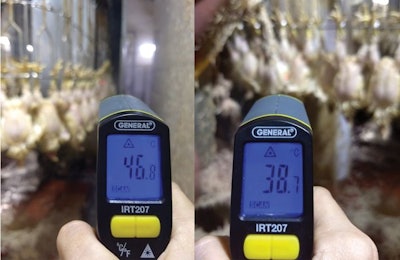
Ensuring the best possible feather plucking of broiler carcasses at the processing plant needs to be considered long before birds reach the plucking machines.
Pre-plucking checks
Particular care needs to be taken when birds are stunned. If, for example, too much current is applied, greater muscular contraction will occur, and this will make removal of the tail and wing feathers, which spring from the muscles, more difficult.
Similarly, with bleed time, a balance needs to be struck between ensuring that birds are dead and the onset of rigor mortis.
Once birds reach the scalders, there are two particularly important aspects that need to be considered: water agitation and total immersion.
The continuous movement of water in the scalding tank separates the feathers, allowing water to reach the skin. This leads to the follicles opening and the feathers loosening.
Birds need to be totally immersed in the tank as, should they remain at the surface, they will be moved toward the tank sides, meaning that one of their wings will not be completely exposed to the water, making feather removal more difficult. Similar difficulties may result for the removal of tail feathers if birds are not fully immersed. Heat is particularly important for follicle dilation, and it is worth remembering that these wing and tail feathers are the most difficult to remove.
When birds leave the scalder, they can lose a lot of the heat that was absorbed during scalding. It is important to retain this heat, and its loss can easily be detected simply through touch. Heat dilates the follicles, and its loss will result in them closing and so anchoring the feathers more firmly.
One way that heat loss can be reduced is through construction of a tunnel-like structure over the route to first plucker. Additionally, warm water sprinklers could also be installed. Heat preservation is important while the carcasses are actually being plucked, and covering the plucking machines can help to achieve this.

Construction of a tunnel over the route from the scalder to the plucking operations can help carcasses retain heat. Eduardo Cervantes López
How to manage plucking
Plucking machines should be slightly inclined toward their exit, helping to increase contact between the plucking fingers and the wings. This greater contact is important as feathers on the wings tend to be overlapping and closer to the body. The incline will also help to counter the tendency of wings to drop as the bird passes through the plucker and, without it, contact with the fingers will be reduced.
Water is used to keep plucking fingers free from feather accumulation and to reduce the heat caused by friction. The water temperature should be 34-38 C. Should the temperature rise above this, there is the risk that the rubber may crystallize and break.
How well birds fit into the shackles also has an important impact at this stage. If legs are thick, they may not pass all the way down to the bottom of the shackle, and this is an increasing problem as more birds are not processed at a heavier weight. Conversely, if legs are too thin, they may not fit snugly into the shackles. In both cases, the problem lies with the rigidity of the shackles, and it is now possible to purchase shackles that adjust to leg thickness ensuring that, once birds have been hung, they do not fall or are hung by only one leg.
Great care needs to be paid to rubber finger management to prevent rejects due to dislocated wings, or scratching, for example. It is worth remembering that the upper fingers, when raised, should not come into contact with the shackles, or they will wear away more quickly. There should be a gap of at least 5 mm between the fingers and the shackles.
Usually, plucking machines have two or three lateral disks. The hardness of the fingers should reflect the characteristics of the broiler skin, taking into consideration feathered and non-feathered areas. For example, a machine with three lateral lines should, as a rule of thumb, have Hard 63 fingers on the on the upper and lower lines, and Medium 58 in the middle, although each plant must make its own decision on finger combination to prevent carcass damage.
It is also worth remembering that, during the daily replacement of plucking fingers, they should be stretched as little as possible when fitted to the disks to ensure they are properly fitted.
To check whether fingers are being managed properly, a simple formula can be applied. The total number of plucking fingers used during a month can be divided by the number of birds processed. This figure should then be multiplied by 1,000 to give the number of fingers used to process 1,000 birds. Finger manufacturers have calculated that processors should be using a maximum of 0.6 fingers per 1,000 birds processed.
It is also worth keeping in mind that that a plucking finger’s useful life is not simply determined by its quality, but also be the quality of the other components in the processing plant that lead to plucking.
How to ensure quality, speed during broiler harvesting

















